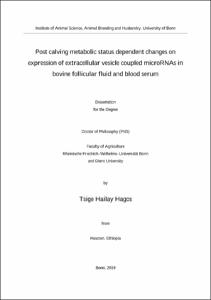Hagos, Tsige Hailay: Post calving metabolic status dependent changes on expression of extracellular vesicle coupled microRNAs in bovine follicular fluid and blood serum. - Bonn, 2019. - Dissertation, Rheinische Friedrich-Wilhelms-Universität Bonn, University of Ghent.
Online-Ausgabe in bonndoc: https://nbn-resolving.org/urn:nbn:de:hbz:5-56655
Online-Ausgabe in bonndoc: https://nbn-resolving.org/urn:nbn:de:hbz:5-56655
@phdthesis{handle:20.500.11811/8023,
urn: https://nbn-resolving.org/urn:nbn:de:hbz:5-56655,
author = {{Tsige Hailay Hagos}},
title = {Post calving metabolic status dependent changes on expression of extracellular vesicle coupled microRNAs in bovine follicular fluid and blood serum},
school = {{Rheinische Friedrich-Wilhelms-Universität Bonn} and {University of Ghent}},
year = 2019,
month = nov,
volume = 193,
note = {Most high yielding dairy cows enter a state of negative energy balance (NEB) during early lactation. This phenomenon is associated with disturbed metabolic status of the cows reflected in the blood and follicular fluid (FF) microenvironment leading to ovarian dysfunction. Extracellular vesicles (EVs) are evolutionarily conserved communicasomes with cargo molecules found in most biological fluids including follicular fluid and they transport different bioactive molecules such as miRNAs, proteins, and lipids from donor to recipient target cells. This dissertation is aimed to investigate the association between post-calving metabolic status and the expression of EV-coupled miRNAs in FF and blood serum of Holstein-Friesian cows. Moreover, the effect of lactation physiology on the expression of EV-coupled miRNAs in FF and blood serum was conducted by comparing lactating cows and heifers. For this, FF samples were collected from large follicles using ovum pick-up procedure from cows (n=30) at weeks 5-10 of post-calving. FF samples collected from heifers (n=8) were used as a control. Parallel to FF collection, blood samples were collected from all experimental animals. Screening of the energy balance status of cows was performed using blood metabolite concentration, body weight, and overall energy based on dry matter intake prior to sample pooling. Following this, EVs were isolated from pooled FF and serum samples using ultracentrifugation and miRNAs expression analysis was performed using Illumina based Next-generation sequencing. Results of energy balance analysis revealed that the majority of the cows (66%) were transient (TCs), whereas the remaining cows exhibited either always negative (ANCs) (17%) or always positive (APCs) (17%). Sequencing results revealed that, a total of 356 and 179 known miRNAs across all samples were detected in FF and serum samples, respectively. Hierarchical clustering and pairwise differential expression analysis of EV-coupled miRNAs in FF and serum revealed major downregulation of miRNAs in metabolically stressed cows. Furthermore, specific EV-coupled miRNAs (bta-miRNA-122, bta-miRNAs-150, bta-miRNA-9-5p, and bta-miRNA-196) were commonly detected with similar pattern of expression in ANCs vs heifers in serum and FF. Moreover, comparison of APCs vs heifers revealed that, lactation has induced the expression of EV-coupled miRNAs in FF but not in the blood serum. In conclusion, cows with divergent metabolic status showed distinct pattern of expression of EV-coupled miRNAs, which can be excellent input for further studies aiming at development of noninvasive molecular indicator of metabolic stress in dairy cows.},
url = {https://hdl.handle.net/20.500.11811/8023}
}
urn: https://nbn-resolving.org/urn:nbn:de:hbz:5-56655,
author = {{Tsige Hailay Hagos}},
title = {Post calving metabolic status dependent changes on expression of extracellular vesicle coupled microRNAs in bovine follicular fluid and blood serum},
school = {{Rheinische Friedrich-Wilhelms-Universität Bonn} and {University of Ghent}},
year = 2019,
month = nov,
volume = 193,
note = {Most high yielding dairy cows enter a state of negative energy balance (NEB) during early lactation. This phenomenon is associated with disturbed metabolic status of the cows reflected in the blood and follicular fluid (FF) microenvironment leading to ovarian dysfunction. Extracellular vesicles (EVs) are evolutionarily conserved communicasomes with cargo molecules found in most biological fluids including follicular fluid and they transport different bioactive molecules such as miRNAs, proteins, and lipids from donor to recipient target cells. This dissertation is aimed to investigate the association between post-calving metabolic status and the expression of EV-coupled miRNAs in FF and blood serum of Holstein-Friesian cows. Moreover, the effect of lactation physiology on the expression of EV-coupled miRNAs in FF and blood serum was conducted by comparing lactating cows and heifers. For this, FF samples were collected from large follicles using ovum pick-up procedure from cows (n=30) at weeks 5-10 of post-calving. FF samples collected from heifers (n=8) were used as a control. Parallel to FF collection, blood samples were collected from all experimental animals. Screening of the energy balance status of cows was performed using blood metabolite concentration, body weight, and overall energy based on dry matter intake prior to sample pooling. Following this, EVs were isolated from pooled FF and serum samples using ultracentrifugation and miRNAs expression analysis was performed using Illumina based Next-generation sequencing. Results of energy balance analysis revealed that the majority of the cows (66%) were transient (TCs), whereas the remaining cows exhibited either always negative (ANCs) (17%) or always positive (APCs) (17%). Sequencing results revealed that, a total of 356 and 179 known miRNAs across all samples were detected in FF and serum samples, respectively. Hierarchical clustering and pairwise differential expression analysis of EV-coupled miRNAs in FF and serum revealed major downregulation of miRNAs in metabolically stressed cows. Furthermore, specific EV-coupled miRNAs (bta-miRNA-122, bta-miRNAs-150, bta-miRNA-9-5p, and bta-miRNA-196) were commonly detected with similar pattern of expression in ANCs vs heifers in serum and FF. Moreover, comparison of APCs vs heifers revealed that, lactation has induced the expression of EV-coupled miRNAs in FF but not in the blood serum. In conclusion, cows with divergent metabolic status showed distinct pattern of expression of EV-coupled miRNAs, which can be excellent input for further studies aiming at development of noninvasive molecular indicator of metabolic stress in dairy cows.},
url = {https://hdl.handle.net/20.500.11811/8023}
}






